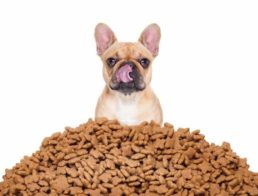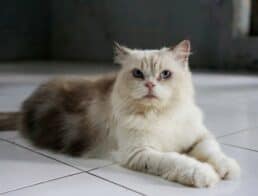You may love your fluffy kitty, no matter her size, but if your cat starts struggling with obesity, it may be time to put your fat cat on a diet. Talk to your vet before you take any drastic measures, but once you do, you may find getting your cat to diet is even harder than sticking to your own diet. No matter how resistant she is to the changes you make for her health, you can follow a few steps to minimize your struggle and get your cat back on track to a healthy life.
1. Determine if a Diet is Necessary
The first step you need to take in order to determine if your cat needs to begin a diet is to talk to your vet. If she’s gained a noticeable amount in a short time, it may be an indication that something is amiss health-wise. The average house cat is between 8 to 10 pounds, so if she’s within that range, you likely don’t have cause for concern. If she’s too far beyond that, though, a visit to your veterinarian may be in order.
Weight gain or loss may be related to an underlying condition such as thyroid disease or diabetes, so you’ll need to rule these potential concerns out before starting your cat on a diet.
2. Monitor Your Cat’s Food Closely
The biggest reason cats gain too much weight is that they overeat. Most cats can self-regulate at least earlier in life. When they get older and become less active, though, they may get into a habit of eating on a particular schedule (despite their lower activity level) or out of boredom. So, keeping a closer eye on her food intake becomes more important once she starts struggling with her weight.
Measure out her food to make sure she isn’t getting more food per day than she should be. Usually, dry cat food has about 300 calories per cup and a 6-ounce can of wet food contains about 250 calories. The average 8-pound cat should be getting about 4/5 a cup of cat food per day, or just under one 6-ounce can of wet food each day. If you split this up into two separate meals, that means just under half a cup of dry food and about three ounces of wet food at each meal.
An automatic cat feeder is one tool you can use to ensure that your cat is getting a precise amount of food at each meal. Check out our list of the Best Automatic Cat Feeders to find one that works for you.
3. Keep Your Kitty Well Hydrated
Cats are a lot like people when eating: they will often feel hungry and eat when they’re really just thirsty. Having access to water at all times will minimize your cat’s overeating, and if she has access to her water even when she is a bit peckish, she’ll likely whine less for food. Not to mention, any time she has her body well hydrated, she’s better prepared for a healthy and active lifestyle. So making sure the cat is ultra-hydrated is nothing but a win/win scenario.
4. Limit Access to Food and Treats
Don’t let your cat have unlimited, free reign over her food. Put her food down for 15 minutes and then, if she hasn’t eaten it, pick it back up. This will keep her from eating leisurely whenever she feels like it, and it will keep you by her dish so you know exactly how much she’s eating.
You’ll definitely want to minimize how many treats you give your kitty, but if you are giving your cat treats, opt for healthy, low-fat treats. However, you may find rewards can be replaced with just one piece of her regular cat food. And despite your previous habits, never give your cat human food – no matter how much she begs.
5. Pick a Lean Cat Food
Ask your vet for recommendations on what kind of cat food is best for your cat, particularly if your cat has any underlying health conditions or medical history that may impact her dietary needs. That said, there are plenty of weight-control cat foods that are suitable for most healthy (other than those extra pounds) cats.
Wet cat food tends to have more calories, and cats tend to eat a larger quantity of wet food in order to feel satisfied. So she may be eating a similar or same quantity of wet food as she would dry food, but the calorie intake is greater. If your cat is on a regular wet-food diet, a switch to dry food may help her to lose weight.
Check out our list of the Best Organic Cat Foods for some healthy, natural options for your favorite feline.
6. Get Her More Active
Fortunately, there are a lot of options that you can take to make and keep your cat active. Laser pointers can work to let you get your kitty a workout without having to do too much movement yourself, if that’s a concern. The sticks with feathers at the end are another good option to encourage play with your cat. You can also choose a play ball or even a more complex cat toy to pique her curiosity. You can also let your cat out more often, but with that comes the risk of her increasing her caloric intake with prey she hunts outdoors, so be mindful of this if your cat is an indoor/outdoor kitty.
Unfortunately, you may find that as your cat ages, you’ll struggle with motivating her to move more than she has been accustomed to. You may not be able to do much besides physically taking her on walks with a leash, and even then, you may struggle with her just plopping down in defiance to the new workout routine. Cats aren’t dogs, after all. Do your best to make sure your cat remains active from her youth through adulthood.
Whether your cat likes the diet or not, you know what she needs to maintain a healthy lifestyle, and if she struggles, it’s your job as the pet parent to make sure she falls in line. While she may be the boss of your heart, you need to make sure her heart is healthy, and that means a healthy diet. That way you’ll be able to enjoy her company for years to come.
































